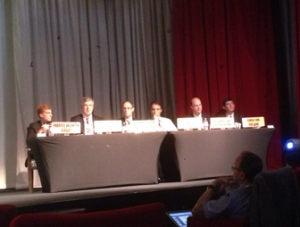Trends from the SpeedNews aerospace fair in Toulouse – brief and to the point
![]()
More than 80 delegates, primarily decision-makers from OEMs and tier-1 suppliers, met at the 15th SpeedNews aerospace suppliers’ fair in Toulouse from September 15 to 17, 2014. The organizer, Joanna Speed, welcomed Matthias Gramolla, Head of Procurement Strategy and Services at Airbus, as keynote speaker. Similar to previous SpeedNews conferences, there was a effectual mix consisting of
- Product and forecast presentations by OEMs
- Presentations by major engine manufacturers and noted tier-1 suppliers
- Assessments of the industry’s current trends given by consultancies and banks
- Plus a panel discussion on the last day of the fair
From the various presentations and discussions I was able to discern the following trend topics:
A + B still lead the way
When it comes to volume business with twin-jet single-aisle aircrafts for more than 150 passengers Airbus and Boeing are still the ones setting the tone. The A320 family from Airbus and the 737 family from Boeing remain the main sales and earnings pillars of these two big players. The current focus is on new, more efficient engines, such as the A320 NEO (new engine option) with LEAP 1A or PW1100G engines, and the Boeing 737 MAX with LEAP 1B engines.
For medium and long range wide-body aircrafts, there are two brand-new highly efficient twin-engined competitors in the starting-blocks, namely the A350 and the 787 Dreamliner, whose volume and sales are significantly more important than those of their large 4-engined siblings, the elderly 747 and the A380, the largest passenger aircraft in the world, whose sales figures are comparatively modest.
There are a number of lively players in the categories below 150 passengers, the most prominent being Bombardier and Embraer. Although I don’t think Bombardier’s C-Series has yet fulfilled the company’s own targets, Embraer is well on track in the 70 to 130-seat category with successful models such as the E195 2.
Full order books for years to come, plus a shift in the gravitational center
Looking at growth rates in the major regions of the world, it is quite noticeable that both Asia-Pacific and the Middle East are well on the way to overtaking traditional markets such as Europe. This can be demonstrated by recent and projected growth rates and increasing air traffic in those regions due to growing prosperity in key countries.
In this context it is telling that Turkey, the UAE and China are opening new airports in record breaking time while the new Berlin Brandenburg Willy Brandt airport BER remains unopened after years at a standstill.
However, Europe still has a key role to play: significant parts of the value chain for players such as Airbus are still located in Europe together with the necessary expertise. With its new final assembly line in Mobile, Alabama, Airbus is directly targeting Boeing’s home market. The argument that – to secure American jobs – Boeing be sole supplier for all American Airlines, will no longer do. Expected annual growth rates of about 7%, with a typical value creation share of 75% from suppliers, certainly guarantee full order books but also make high demands on their capacity for performance and growth. This leads us directly to the third main topic:
Why collaboration between suppliers is a critical success factor for the industry’s growth
Anyone who listened to what engine manufacturers and tier-1 aerostructures had to say at SpeedNews will have been able to verify the key role supplier collaboration will play in the anticipated growth (an expected doubling of aircraft production figures over the next 10-15 years): Alongside the ramp-up for the A320 NEO e.g., the A320 CEO (conventional engine option) will still be available – because whoever will be the first to fulfill the demand will get the business.
However, fulfilling demand is not only dependent on tier-1s and tier-2s but also on raw materials: keeping the supply chain provided with aluminum, titanium, steel and composites will also have a significant impact on whether the ambitious growth targets can be fulfilled.
Because one thing is certain: a supply chain is only as strong as its weakest link.




